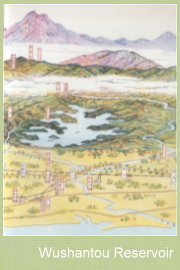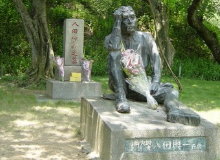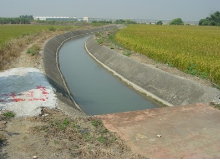|
◆《Early
period of cultivation- Tian-Tian tillage method (Weather reliance)》
Houbi Town cultivation began as early as the
Ming-Cheng Period. After Ching Dynasty, cultivated lands expanded in
size. In accordance with bibliographical data recorded during Ching
Dynasty, there are 5 farm ponds in Houbi Town completed during Kang
Shi period. It shows that water rice field cultivation took place
during early Ching Dynasty in Houbi Town. However, the Ching
hydraulic facilities were rather simple at the time and were not
durable. Irrigation zones were quite limited as well. Therefore most
rice fields relied on the “weather” for tillage. It is otherwise
known as the “Tian-Tian” type of tillage method.
◆《Chia-Nan
Irrigation River construction- began rice,Sugarcane, and multi-
grain tillage in 3-year crop rotation》
 During
Japanese colonization in Taiwan, the colonial policy of
“Industrialization in Japan and Agricultural Development in Taiwan”
was adopted. In 1920, the Japanese government began Guang-Tian creek
reservoir and canal construction in the vast Chian-Nan
Plains.(Wushantou Reservoir and Chia-Nan River) The entire water
control project took 10 years to complete. (Completed in 1993) After
the waters started to flow, the supposedly dry rice fields became
water rice fields as it received abundant irrigation waters. The
Irrigation Zone is said to be 15,000 acres. During
Japanese colonization in Taiwan, the colonial policy of
“Industrialization in Japan and Agricultural Development in Taiwan”
was adopted. In 1920, the Japanese government began Guang-Tian creek
reservoir and canal construction in the vast Chian-Nan
Plains.(Wushantou Reservoir and Chia-Nan River) The entire water
control project took 10 years to complete. (Completed in 1993) After
the waters started to flow, the supposedly dry rice fields became
water rice fields as it received abundant irrigation waters. The
Irrigation Zone is said to be 15,000 acres.
Although Wushantou Reservoir and Chia-Nan River were the largest
water control projects in Taiwan, due to natural environment
limitations (vast tillage land and small water collection areas),
the river water supply failed to meet the needs of Irrigation Zones.
Therefore the 3-year crop rotation planting method was adopted to
conserve water source. Houbi Town was subsequently included as part
of the 3-year crop rotation confines. In accordance with records of
Houbi town, the crop rotation method was planting rice, yam, and
sugarcane in crop rotation. The Japanese actively engaged in sugar
industrial developments in Taiwan to increase raw material supply in
the society. Peasants were pressured and forced to plant sugarcane
continuously without rest.
|
3-year crop rotation method》》
The 3-year crop rotation method is based
on land location and hydraulic system.150acres of land is
one water area and each water area is divided into 3 50-acre
sub-areas. Rice and sugar cane are planted in each of the
sub-areas. These two areas had to be irrigated whenever
necessary. The other sub-area was reserved for miscellaneous
tillage. No water supply is provisioned for this sub-area.
The three sub-areas are rotated every 3 years where
different crop planting and irrigation are carried out.
Peasants are entitled to equal rights and benefits. This
type of crop rotation method continues to be implemented
after Taiwan retrocession. |
 |
 |
|
The river designer“Ha Ta Yo I
Chi”
is known as the River Father.
Each year, a memorial meeting
is held in
memory of him. |
Reservoir water flows in
sequence into river mainstreams
and tributaries,
sub-tributaries,
and water ways before flowing
into rice fields |
◆《After Zengwun Reservoir
was completed, water supply increased –“Double Paddy Crops for Every
Year” was adopted》
After Taiwan retrocession, the same
agricultural method adopted was generally adopted. With inadequate
water source and government promotion of sugarcane planting,
peasants of Houbi Town had little chance to plant rice. By October,
1973, another reservoir in Chia-Nan Plain, Zengwun Resrervoir was
completed and ready to conserve water. It operated in collaboration
with Wushantou Reservoir. Ever since, the water supply increased
abundantly, and it effectively solved the problem of irrigation
water inadequacy of Wushantou Reservoir.
Due to irrigation water supply changes, Chia-Nan Irrigation
Association also altered the existing irrigation system. With the
exception of few tillage lands in Houbi Town that engage in double
paddy crops for every 3 years, the rest of the lands were included
as part of the Double Paddy Crops for Every Year zone. Rice planting
is done every year. The original single paddy crop (second stage)
became double paddy crop (first and second stage). The rice
production volume chart below shows that after Zengwun Reservoir
started supplying water, the first stage crop volume increased
6-fold. As production volume rapidly increased, rice became the main
crop of Houbi Town, which in turn became the largest rice storehouse
in Tainan County. |